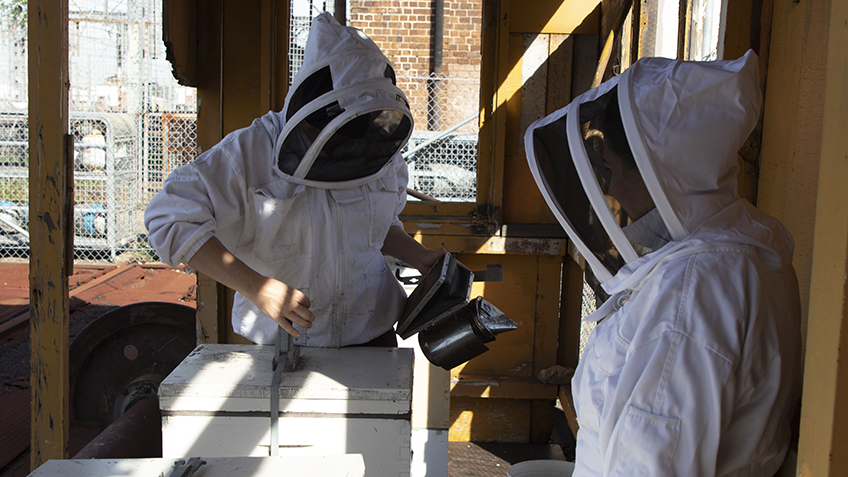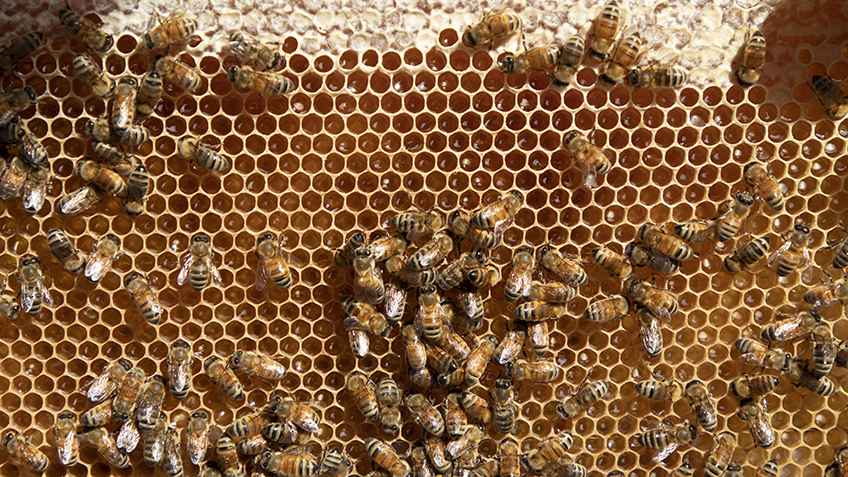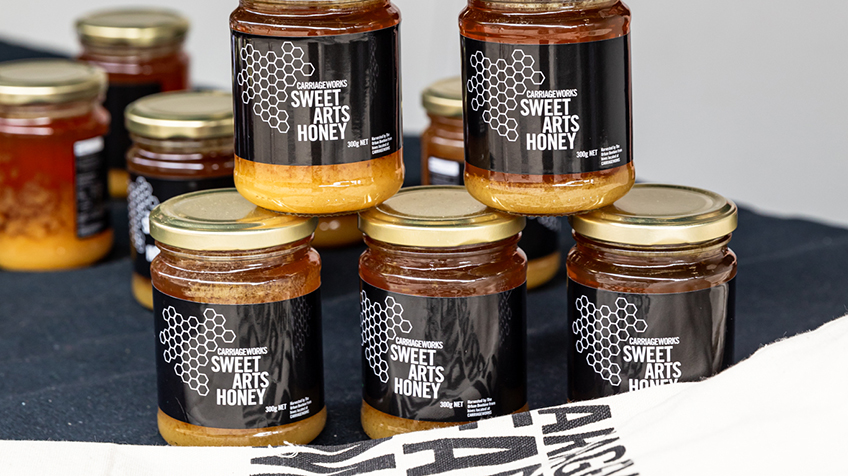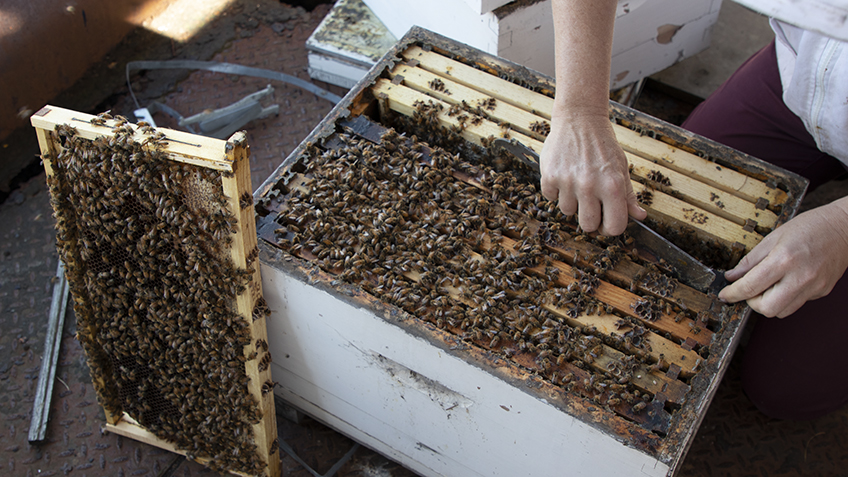Did you know that Carriageworks is home to four rescued beehives?
It’s all thanks to the The Urban Beehive who are responsible for managing our hives and harvesting their sweet honey which is then packaged and sold at the market.
The Urban Beehive is driven by two beekeepers, Doug Purdie and Vicky Brown, who met through the NSW Beekeepers Association and have been urban beekeeping in Sydney for near 15 years.
Our Carriageworks team put on a beekeeping suit and joined Vicky in harvesting the honey and then sat down to find out more about The Urban Beehive, how location can inform honey flavour and the importance of planting flora.
What drew you to beekeeping?
Both Doug and I were introduced and became interested in beekeeping from different avenues. Doug was fundraising for his community by selling local honey and realised bees were vital as pollinators in cities and wanted to raise awareness about their importance to the people of Sydney. Before moving to the city I worked with an organic commercial beekeeper on Kangaroo Island for three seasons and later once settled in Sydney missed them dearly and felt, like Doug, how great it would be to have beehives in the city.
We know each hive has its own name and unique personality – can you tell us about each hive at Carriageworks?
Carriageworks has four beehives in residence.
Fish Tail – Originally from near the shores of Bondi Beach this was a spring colony from a community garden and who travelled from locations of Manly to Rosebery before settling at Carriageworks. A clamer hive with small bees, much quieter than the others but still productive.
RPAH – A swarm rescued in 2014 from the hospital who has been an inner west local, previously located in Vicky’s garden in Marrickville before moving to Carriageworks. Produced the most honey in the 2020-2021 season and still going strong!
Nobody Knows – A swarm rescued in Vicky’s garden but did not originate from the beehives located there. Nobody knew where they flew in from and the name stuck! Always a little confusing with their behaviour around spring but a gentle beehive.
Geoff – A swarm rescued by and hence named after a long time member of the Illawarra Bee club. They lived on Doug’s roof in East Sydney before moving to Carriageworks. A little bit messy with drawing the honeycombs and collecting surplus propolis Geoff has started to settle down and be neater over the years.
Are the bees at Carriageworks harmful?
Some people think of honeybees as an aggressive stinging insect but bees usually only sting when defending the beehive or feeling threatened. The majority of the time honeybees are out foraging, looking for nectar and pollen and not interested in humans at all. The Urban Beehive has a policy of keeping beehives with placid genes. Meaning if any beehives show a tendency to be aggressive while carrying out inspections the defensive queen bee is replaced with a new queen who is much more gentle. The queen bee is the mother of all the bees in each beehive and their behaviour will be a reflection of her genetics.
How often do you visit the beehives at Carriageworks?
The beehives at Carriageworks are inspected on average every three weeks and sometimes more often in spring.
In spring we monitor the beehives for signs of swarming and nectar flow in the area. In summer most inspections are monitoring and harvesting honey stores. Autumn is checking colony health and bedding the beehives down for winter. Winter is when we all have a nice rest before starting all over again in spring.
Right now, the hives going into a less active state during hibernation over winter, can you tell us more about this and the importance of timing for honey harvesting?
As Sydney has such mild winters the beehives at Carriageworks never really go into hibernation but they do slow down. Once the cold weather approaches the queen lays less eggs, so the population does drop compared to other seasons. Some days are sunny in winter so the bees will still leave the beehive and forage on any winter flowering plants, such as some types of Banksias. To get the beehives nice and cosy before winter we take off any surplus honey, leaving just the winter stores for the bees. This allows us to take off extra boxes which the honeybees are not using, meaning they can use less energy keeping the smaller space of the beehive warm.
How much honey do these hives produce?
Each beehive produces on average 50kg per year. This can fluctuate due to the seasonal changes of each year. Sydney is one of the most productive urban environments to keep beehives and we never have to move beehives due to lack of flora for the bees to forage on. There are usually three harvests of the beehives each year, sometimes four.
Can you taste a difference in the honey between each hive or between different locations around Sydney?
Each suburb has a different flavour of honey due to the flora present in the area and foraged on by the bees. As the flowering plants change with each season, so will the nectar collected by the bees. one of the joys of keeping honeybees in an urban setting is getting to experience the change in each harvest.
Is there any information you can tell us specifically about the honey harvested and sold at Carriageworks?
The honey harvested at Carriageworks is a reflection of the trees and plants of Newtown and Redfern. As honeybees forage around a 5km radius from the beehive if you live locally with a flowering garden visited by bees, thank you, as you are supporting the honeybees and may even go towards producing the honey at Carriageworks.
Carriageworks honey, labelled Sweets Arts, is available from the information desk at Carriageworks Farmers Market every Saturday.
Can you tell us more about The Urban Beehive?
The Urban Beehive was established in 2010 by Doug Purdie and Vicky Brown and currently care for approx 100 beehives across Sydney. Education about becoming a beekeeper is also important and we offer short courses for those interested in having a beehive of their own. Our shop in Matraville sells a variety of local honey and beekeeping supplies.
How does urban beekeeping protect and affect local bee populations?
Urban beekeeping is a fantastic hobby which allows for natural pollination of flora in the city environment. European honeybees are not the only bee species suitable for residents of Sydney and many houses and apartments are home to native beehives, such Tetragonula stingless bees and favourite common native bees like the Blue Banded Bee and Teddy Bear bee.
What should you do if you come across a ‘feral’ beehive near your home or workplace?
Contact a local beekeeper or your local bee club who will be able to give the best advice and hopefully relocate the beehive to a more suitable environment.
Is there anything else you’d like to add for our readers?
Honeybees and native bees are important pollinators in urban areas. Not everyone can keep bees but we can all do our part by planting flora which supports pollinators and be aware of the risks of using pesticides.
All pollinators are a reflection of how we treat our environment and by seeding diversity and providing habitats we allow our natural surroundings to thrive.




